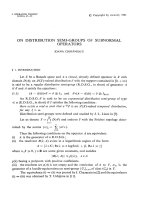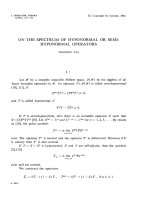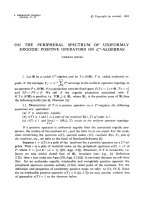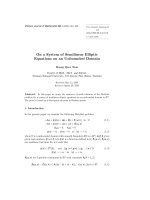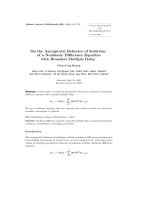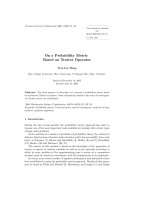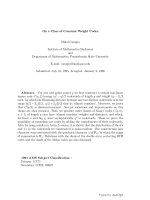Báo cáo toán học: "On a combinatorial problem of Asmus Schmidt" pps
Bạn đang xem bản rút gọn của tài liệu. Xem và tải ngay bản đầy đủ của tài liệu tại đây (103.42 KB, 8 trang )
On a combinatorial problem of Asmus Schmidt
W. Zudilin
∗
Department of Mechanics and Mathematics
Moscow Lomonosov State University
Vorobiovy Gory, GSP-2, Moscow 119992 RUSSIA
URL: />E-mail address:
Submitted: Dec 29, 2003; Accepted: Feb 26, 2004; Published: Mar 9, 2004.
MR Subject Classifications: 11B65, 33C20.
Abstract
For any integer r ≥ 2, define a sequence of numbers {c
(r)
k
}
k=0,1,
, independent
of the parameter n,by
n
k=0
n
k
r
n + k
k
r
=
n
k=0
n
k
n + k
k
c
(r)
k
,n=0, 1, 2, .
We prove that all the numbers c
(r)
k
are integers.
1 Stating the problem
The following curious problem was stated by A. L. Schmidt in [5] in 1992.
Problem 1. For any integer r ≥ 2, define a sequence of numbers {c
(r)
k
}
k=0,1,
, indepen-
dent of the parameter n,by
n
k=0
n
k
r
n + k
k
r
=
n
k=0
n
k
n + k
k
c
(r)
k
,n=0, 1, 2, . (1)
Is it then true that all the numbers c
(r)
k
are integers?
∗
The work is supported by an Alexander von Humboldt research fellowship and partially supported
by grant no. 03-01-00359 of the Russian Foundation for Basic Research.
the electronic journal of combinatorics 11 (2004), #R22 1
An affirmative answer for r = 2 was given in 1992 (but published a little bit later),
independently, by Schmidt himself [6] and by V. Strehl [7]. They both proved the following
explicit expression:
c
(2)
n
=
n
j=0
n
j
3
=
j
n
j
2
2j
n
,n=0, 1, 2, , (2)
which was observed experimentally by W. Deuber, W. Thumser and B. Voigt. In fact,
Strehl used in [7] the corresponding identity as a model for demonstrating various proof
techniques for binomial identities. He also proved an explicit expression for the sequence
c
(3)
n
, thus answering Problem 1 affirmatively in the case r = 3. But for this case Strehl
had only one proof based on Zeilberger’s algorithm of creative telescoping. Problem 1
was restated in [3], Exercise (!) 114 on p. 256, with an indication (on p. 549) that H. Wilf
had shown the desired integrality of c
(r)
n
for any r but only for any n ≤ 9.
We recall that the first non-trivial case r = 2 is deeply related to the famous Ap´ery
numbers
k
n
k
2
n+k
k
2
, the denominators of rational approximations to ζ(3). These
numbers satisfy a 2nd-order polynomial recursion discovered by R. Ap´ery in 1978, while
an analogous recursion (also 2nd-order and polynomial) for the numbers (2) was indicated
by J. Franel already in 1894.
The aim of this paper is to give an answer in the affirmative to Problem 1 (Theorem 1)
by deriving explicit expressions for the numbers c
(r)
n
, and also to prove a stronger result
(Theorem 2) conjectured in [7], Section 4.2.
Theorem 1. The answer to Problem 1 is affirmative. In particular, we have the explicit
expressions
c
(4)
n
=
j
2j
j
3
n
j
k
k + j
k − j
j
n − k
k
j
2j
k − j
, (3)
c
(5)
n
=
j
2j
j
4
n
j
2
k
k + j
k − j
2
2j
n − k
2j
k − j
, (4)
and in general for s =1, 2,
c
(2s)
n
=
j
2j
j
2s−1
n
j
k
1
j
n − k
1
k
1
j
k
1
+ j
k
1
− j
k
2
2j
k
1
− k
2
k
2
+ j
k
2
− j
2
···
×
k
s−1
2j
k
s−2
− k
s−1
k
s−1
+ j
k
s−1
− j
2
2j
k
s−1
− j
,
c
(2s+1)
n
=
j
2j
j
2s
n
j
2
k
1
2j
n − k
1
k
1
+ j
k
1
− j
2
k
2
2j
k
1
− k
2
k
2
+ j
k
2
− j
2
···
×
k
s−1
2j
k
s−2
− k
s−1
k
s−1
+ j
k
s−1
− j
2
2j
k
s−1
− j
,
where n =0, 1, 2, .
the electronic journal of combinatorics 11 (2004), #R22 2
2 Very-well-poised preliminaries
The right-hand side of (1) defines the so-called Legendre transform of the sequence
{c
(r)
k
}
k=0,1,
. In general, if
a
n
=
n
k=0
n
k
n + k
k
c
k
=
n
k=0
2k
k
n + k
n − k
c
k
,
then by the well-known relation for inverse Legendre pairs one has
2n
n
c
n
=
k
(−1)
n−k
d
n,k
a
k
,
where
d
n,k
=
2n
n − k
−
2n
n − k − 1
=
2k +1
n + k +1
2n
n − k
.
Therefore, putting
t
(r)
n,j
=
n
k=j
(−1)
n−k
d
n,k
k + j
k − j
r
, (5)
we obtain
2n
n
c
(r)
n
=
n
j=0
2j
j
r
t
(r)
n,j
. (6)
The case r = 1 of Problem 1 is trivial (that is why it is not included in the statement of
the problem), while the cases r =2andr = 3 are treated in [6], [7] using the fact that
t
(2)
n,j
and t
(3)
n,j
have a closed form. Namely, it is easy to show by Zeilberger’s algorithm of
creative telescoping [4] that the latter sequences, indexed by either n or j, satisfy simple
1st-order polynomial recursions. Unfortunately, this argument does not exist for r ≥ 4.
V. Strehl observed in [7], Section 4.2, that the desired integrality would be a con-
sequence of the divisibility of the product
2j
j
r
· t
(r)
n,j
by
2n
n
for all j,0≤ j ≤ n.He
conjectured a much stronger property, which we are now able to prove.
Theorem 2. The numbers
2n
n
−1
2j
j
t
(r)
n,j
are integers.
Our general strategy for proving Theorem 2 (and hence Theorem 1) is as follows:
rewrite (5) in a hypergeometric form and apply suitable summation and transformation
formulae (Propositions 1 and 2 below).
Changing l to n − k in (5) we obtain
t
(r)
n,j
=
l≥0
(−1)
l
2n − 2l +1
2n − l +1
2n
l
n − l + j
n − l − j
r
,
the electronic journal of combinatorics 11 (2004), #R22 3
where the series on the right terminates. It is convenient to write all such terminating
sums simply as
l
, which is, in fact, a standard convention (see, e.g., [4]). The ratio of
two consecutive terms in the latter sum is equal to
−(2n +1)+l
1+l
·
−
1
2
(2n − 1) + l
−
1
2
(2n +1)+l
·
−(n − j)+l
−(n + j)+l
r
,
hence
t
(r)
n,j
=
n + j
n − j
r
·
r+2
F
r+1
−(2n +1), −
1
2
(2n − 1), −(n − j), ,−(n − j)
−
1
2
(2n +1), −(n + j), ,−(n + j)
1
is a very-well-poised hypergeometric series. (We refer the reader to the book [2] for
all necessary hypergeometric definitions. We will omit the argument z = 1 in further
discussions.)
The following two classical results—Dougall’s summation of a
5
F
4
(1)-series (proved
in 1907) and Whipple’s transformation of a
7
F
6
(1)-series (proved in 1926)—will be re-
quired to treat the cases r =3, 4, 5ofTheorems1and2.
Proposition 1 ([2], Section 4.3). We have
5
F
4
a, 1+
1
2
a, c, d, −m
1
2
a, 1+a − c, 1+a − d, 1+a + m
=
(1 + a)
m
(1 + a − c − d)
m
(1 + a − c)
m
(1 + a − d)
m
(7)
and
7
F
6
a, 1+
1
2
a, b, c, d, e, −m
1
2
a, 1+a − b, 1+a − c, 1+a − d, 1+a − e, 1+a + m
=
(1 + a)
m
(1 + a − d − e)
m
(1 + a − d)
m
(1 + a − e)
m
·
4
F
3
1+a − b − c, d, e, −m
1+a − b, 1+a − c, d + e − a − m
, (8)
where m is a non-negative integer, and ( · ) denotes Pochhammer’s symbol.
An application of (7) gives (without creative telescoping)
t
(3)
n,j
=
n + j
n − j
3
·
(−2n)
n−j
(−2n +2(n − j))
n−j
(−2n +(n − j))
2
n−j
=
(2n)!
(3j − n)! (n − j)!
3
,
which is exactly the expression obtained in [7], Section 4.2. Therefore, from (6) we have
the explicit expression
c
(3)
n
=
2n
n
−1
j
2j
j
3
(2n)!
(3j − n)! (n − j)!
3
=
j
2j
j
2
2j
n − j
n
j
2
.
the electronic journal of combinatorics 11 (2004), #R22 4
For the case r = 5, we are able to apply the transformation (8):
t
(5)
n,j
=
n + j
n − j
5
·
(−2n)
n−j
(−2n +2(n − j))
n−j
(−2n +(n − j))
2
n−j
×
4
F
3
−2j, −(n − j), −(n − j), −(n − j)
−(n + j), −(n + j), 3j − n +1
=
n + j
n − j
2
(2n)!
(3j − n)! (n − j)!
3
l
(−2j)
l
(−(n − j))
3
l
l!(−(n + j))
2
l
(3j − n +1)
l
=
(2n)!
(2j)! (n − j)!
2
l
n − l + j
n − l − j
2
2j
l
2j
n − l − j
=
(2n)!
(2j)! (n − j)!
2
k
k + j
k − j
2
2j
n − k
2j
k − j
,
hence
2n
n
−1
2j
j
t
(5)
n,j
=
n
j
2
k
k + j
k − j
2
2j
n − k
2j
k − j
are integers and from (6) we derive formula (4).
To proceed in the case r = 4, we apply the version of formula (8) with b =(1+a)/2
(so that the series on the left reduces to a
6
F
5
(1)-very-well-poised series):
t
(4)
n,j
=
n + j
n − j
4
·
(−2n)
n−j
(−2n +2(n − j))
n−j
(−2n +(n − j))
2
n−j
×
4
F
3
−j, −(n − j), −(n − j), −(n − j)
−n, −(n + j), 3j − n +1
=
n + j
n − j
(2n)!
(3j − n)! (n − j)!
3
l
(−j)
l
(−(n − j))
3
l
l!(−n)
l
(−(n + j))
l
(3j − n +1)
l
=
(2n)! j!
n!(n − j)! (2j)!
l
n − l + j
n − l − j
j
l
n − l
j
2j
n − l − j
=
(2n)! j!
n!(n − j)! (2j)!
k
k + j
k − j
j
n − k
k
j
2j
k − j
,
from which, again,
2n
n
−1
2j
j
t
(4)
n,j
∈ Z and we arrive at formula (3).
3 Andrews’s multiple transformation
It seems that ‘classical’ hypergeometric identities can cover only the cases
1
r =2, 3, 4, 5
of Theorems 1 and 2. In order to prove the theorems in full generality, we will require
1
This is not really true since Andrews’s ‘non-classical’ identity below is a consequence of very classical
Whipple’s transformation and the Pfaff–Saalsch¨utz formula.
the electronic journal of combinatorics 11 (2004), #R22 5
a multiple generalization of Whipple’s transformation (8). The required generalization is
given by G. E. Andrews in [1], Theorem 4. After making the passage q → 1 in Andrews’s
theorem, we arrive at the following result.
Proposition 2. For s ≥ 1 and m a non-negative integer,
2s+3
F
2s+2
a, 1+
1
2
a, b
1
,c
1
,b
2
,c
2
,
1
2
a, 1+a − b
1
, 1+a − c
1
, 1+a − b
2
, 1+a − c
2
,
, b
s
,c
s
, −m
,1+a − b
s
, 1+a − c
s
, 1+a + m
=
(1 + a)
m
(1 + a − b
s
− c
s
)
m
(1 + a − b
s
)
m
(1 + a − c
s
)
m
l
1
≥0
(1 + a − b
1
− c
1
)
l
1
(b
2
)
l
1
(c
2
)
l
1
l
1
!(1+a − b
1
)
l
1
(1 + a − c
1
)
l
1
×
l
2
≥0
(1 + a − b
2
− c
2
)
l
2
(b
3
)
l
1
+l
2
(c
3
)
l
1
+l
2
l
2
!(1+a − b
2
)
l
1
+l
2
(1 + a − c
2
)
l
1
+l
2
···
×
l
s−1
≥0
(1 + a − b
s−1
− c
s−1
)
l
s−1
(b
s
)
l
1
+···+l
s−1
(c
s
)
l
1
+···+l
s−1
l
s−1
!(1+a − b
s−1
)
l
1
+···+l
s−1
(1 + a − c
s−1
)
l
1
+···+l
s−1
×
(−m)
l
1
+···+l
s−1
(b
s
+ c
s
− a − m)
l
1
+···+l
s−1
.
Proof of Theorem 2. As in Section 2, we will distinguish the cases corresponding to the
parity of r.
If r =2s+1, then setting a = −(2n+1) and b
1
= c
1
= ···= b
s
= c
s
= −m = −(n−j)
in Proposition 2 we obtain
t
(2s+1)
n,j
=
n + j
n − j
2s−2
(2n)!
(3j − n)! (n − j)!
3
l
1
2j
l
1
(−(n − j))
l
1
(−(n + j))
l
1
2
×
l
2
2j
l
2
(−(n − j))
l
1
+l
2
(−(n + j))
l
1
+l
2
2
···
×
l
s−1
2j
l
s−1
(−(n − j))
l
1
+···+l
s−1
(−(n + j))
l
1
+···+l
s−1
2
×
(−1)
l
1
+···+l
s−1
(−(n − j))
l
1
+···+l
s−1
(3j − n +1)
l
1
+···+l
s−1
=
(2n)!
(2j)! (n − j)!
2
l
1
2j
l
1
n − l
1
+ j
n − l
1
− j
2
l
2
2j
l
2
n − l
1
− l
2
+ j
n − l
1
− l
2
− j
2
···
×
l
s−1
2j
l
s−1
n − l
1
−···−l
s−1
+ j
n − l
1
−···−l
s−1
− j
2
·
2j
n − l
1
−···−l
s−1
− j
.
If r =2s, we apply Proposition 2 with the choice a = −(2n +1),b
1
=(a +1)/2=−n
the electronic journal of combinatorics 11 (2004), #R22 6
and c
1
= b
2
= ···= b
s
= c
s
= −m = −(n − j):
t
(2s)
n,j
=
n + j
n − j
2s−3
(2n)!
(3j − n)! (n − j)!
3
l
1
j
l
1
(−(n − j))
l
1
(−n)
l
1
(−(n − j))
l
1
(−(n + j))
l
1
×
l
2
2j
l
2
(−(n − j))
l
1
+l
2
(−(n + j))
l
1
+l
2
2
···
×
l
s−1
2j
l
s−1
(−(n − j))
l
1
+···+l
s−1
(−(n + j))
l
1
+···+l
s−1
2
×
(−1)
l
1
+···+l
s−1
(−(n − j))
l
1
+···+l
s−1
(3j − n +1)
l
1
+···+l
s−1
=
(2n)! j!
n!(n − j)! (2j)!
l
1
j
l
1
n − l
1
j
n − l
1
+ j
n − l
1
− j
×
l
2
2j
l
2
n − l
1
− l
2
+ j
n − l
1
− l
2
− j
2
···
×
l
s−1
2j
l
s−1
n − l
1
−···−l
s−1
+ j
n − l
1
−···−l
s−1
− j
2
·
2j
n − l
1
−···−l
s−1
− j
.
In both cases, the desired integrality
2n
n
−1
2j
j
t
(r)
n,j
∈ Z,j=0, 1, ,n,
clearly holds, and Theorem 2 follows.
Theorem 1 was actually proved during the proof of Theorem 2 with explicit expressions
being obtained for c
(4)
n
, c
(5)
n
and general c
(r)
n
, r ≥ 2.
We would like to conclude the paper by the following q-question.
Problem 2. Find and solve an appropriate q-analogue of Problem 1.
Acknowledgements. I was greatly encouraged by C. Krattenthaler to prove binomial iden-
tities by myself. I thank him for our fruitful discussions and for pointing out to me
Andrews’s formula. I thank J. Sondow for several suggestions that allowed me to improve
the text of the paper. This work was done during a long-term visit at the Mathemat-
ical Institute of Cologne University. I thank the staff of the institute and personally
P. Bundschuh for the brilliant working atmosphere I had there.
References
[1] G. E. Andrews, “Problems and prospects for basic hypergeometric functions”, Theory and
application of special functions (Proc. Advanced Sem., Math. Res. Center, Univ. Wisconsin,
the electronic journal of combina t orics 11 (2004), #R22 7
Madison, Wis., 1975), ed. R. A. Askey, Math. Res. Center, Univ. Wisconsin, Publ. No. 35,
Academic Press, New York, 1975, pp. 191–224.
[2] W. N. Bailey, Generalized hypergeometric series, Cambridge Math. Tracts 32, Cambridge
Univ. Press, Cambridge, 1935; 2nd reprinted edition, Stechert-Hafner, New York–London,
1964.
[3] R. L. Graham, D. E. Knuth, and O. Patashnik, Concrete mathematics. A foundation for
computer science, 2nd edition, Addison-Wesley Publishing Company, Reading, MA, 1994.
[4] M. Petkovˇsek, H. S. Wilf, and D. Zeilberger, A = B, A. K. Peters, Ltd., Wellesley, MA, 1996.
[5] A. L. Schmidt, “Generalized q-Legendre polynomials”, Proc. of the 7th Spanish Symposium
on Orthogonal Polynomials and Applications (VII SPOA) (Granada, 1991), J. Comput.
Appl. Math. 49:1–3 (1993), 243–249.
[6] A. L. Schmidt, “Legendre transforms and Ap´ery’s sequences”, J. Austral. Math. Soc. Ser. A
58:3 (1995), 358–375.
[7] V. Strehl, “Binomial identities—combinatorial and algorithmic aspects”, Discrete Math.
136:1–3 (1994), 309–346.
the electronic journal of combinatorics 11 (2004), #R22 8

